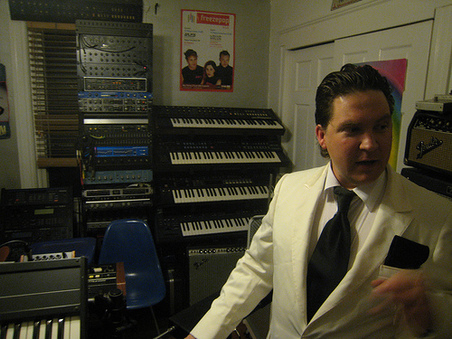
I recently took delivery of a Gristleizer module from Anthony Norton at Analog Craftsman. Tony makes some interesting, large format modules as well as doing custom work. If there is a Eurorack module that you would like to have converted for use on your man sized system, Tony is your man.
Tony, age 40, is from Belfast, Maine. Currently reside in Arlington, MA and Eastman, NH with wife Jen and son Maxton. They have two dogs, Daisy & Bam Bam and (the inevitable I suppose) cat, Sheba.
He was an undergrad at Castleton State College (BS Comm) and a graduate of Indiana University (Master Science Music Technology).
Tony has a 12 year career in motion picture lighting, then a 7 year career as part time faculty at New England Institute of Art teaching various music technology classes: physics of sound, listening and analysis, digital audio theory, music theory, music synthesis and sampling. He founded analog craftsman in January of 2012.
Tony, age 40, is from Belfast, Maine. Currently reside in Arlington, MA and Eastman, NH with wife Jen and son Maxton. They have two dogs, Daisy & Bam Bam and (the inevitable I suppose) cat, Sheba.
He was an undergrad at Castleton State College (BS Comm) and a graduate of Indiana University (Master Science Music Technology).
Tony has a 12 year career in motion picture lighting, then a 7 year career as part time faculty at New England Institute of Art teaching various music technology classes: physics of sound, listening and analysis, digital audio theory, music theory, music synthesis and sampling. He founded analog craftsman in January of 2012.
1- How did you get started with synthesizers?
I was asked to fill in at drums for a band my freshman year of high school because the drummer had to go to a wedding. Those folks I would continue to play/write/produce with to this day. Last gig together two weeks ago, Williamsburg Music Hall, NYC.
I bought my first synth, a Yamaha PSR-36, at some department store (Service Merchandise?) in early 1988, followed later that April by a full Roland electronic drum set (the old hard plastic pads) with a PM-16 trigger to MIDI box and an Alesis HR-16 drum machine for sounds. I moved from drums to synthesizer the following year and got an Ensoniq EPS for Christmas in 1989. Started sampling/sequencing/programming and writing songs, recording to 4 track cassette. My first analog synth, a Roland SH-101, for $45, in August 1991, which I still have. It's my "bottom bitch." It will be cremated with me.
I slowly collected synthesizers/drum machines throughout the 90's. Highlights include Chroma Polaris for $125, Juno 60 for $300, SP-12 for $200. I feel like I've owned pretty much everything, but I always come back to the SH-101 (though the Model D is a close close second), Korg Polysix, and Prophet VS, those are my desert island synths. Got into modulars about four years ago when I traded my Emulator II for a MOTM voice: 300, 440, 800, 190, 390. I had a few euro modules before that, but large format was where it was at for me and the rest is history. Never looked back.
I was asked to fill in at drums for a band my freshman year of high school because the drummer had to go to a wedding. Those folks I would continue to play/write/produce with to this day. Last gig together two weeks ago, Williamsburg Music Hall, NYC.
I bought my first synth, a Yamaha PSR-36, at some department store (Service Merchandise?) in early 1988, followed later that April by a full Roland electronic drum set (the old hard plastic pads) with a PM-16 trigger to MIDI box and an Alesis HR-16 drum machine for sounds. I moved from drums to synthesizer the following year and got an Ensoniq EPS for Christmas in 1989. Started sampling/sequencing/programming and writing songs, recording to 4 track cassette. My first analog synth, a Roland SH-101, for $45, in August 1991, which I still have. It's my "bottom bitch." It will be cremated with me.
I slowly collected synthesizers/drum machines throughout the 90's. Highlights include Chroma Polaris for $125, Juno 60 for $300, SP-12 for $200. I feel like I've owned pretty much everything, but I always come back to the SH-101 (though the Model D is a close close second), Korg Polysix, and Prophet VS, those are my desert island synths. Got into modulars about four years ago when I traded my Emulator II for a MOTM voice: 300, 440, 800, 190, 390. I had a few euro modules before that, but large format was where it was at for me and the rest is history. Never looked back.

2- What is your training in electronics?
As a faculty member at NEIA I can audit classes for free. We have two levels of musical electronics there, so I took both of those. One was taught by the guy who deigned/invented the Schulz Rockman. Funny story about Tom Schulz calling him on the phone to give him the pitch. Cut my teeth on classic guitar pedals for awhile: Dallas Rangemaster, Maestro FZ-1, Fuzz Face, 2 knob Tone Bender. Eventually parlayed that interest and experience into building modular kits then designing some modules and learning the whole process of design/procurement/fabrication/manufacture. Still learning...
As a faculty member at NEIA I can audit classes for free. We have two levels of musical electronics there, so I took both of those. One was taught by the guy who deigned/invented the Schulz Rockman. Funny story about Tom Schulz calling him on the phone to give him the pitch. Cut my teeth on classic guitar pedals for awhile: Dallas Rangemaster, Maestro FZ-1, Fuzz Face, 2 knob Tone Bender. Eventually parlayed that interest and experience into building modular kits then designing some modules and learning the whole process of design/procurement/fabrication/manufacture. Still learning...
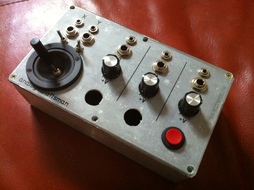 Arcade Prototype
Arcade Prototype 3- What inspires your module designs?
Things that don't exist in large format. My first production module was ARCADE. It combined my love for classic arcade video games with controlling modular synthesizers for both euro and 5U formats. We even have a prototype for a banana version for the Serge/Buchla crowd.
Otherwise, I like offering classic circuits in their original design to folks who cant afford the real thing. Arp and Polivoks VCFs and also the mixer from the Polivoks, both with all original Russian ICs sourced from behind the former iron curtain. Also the venerable Chris Carter Gristleizer. Most of my other production modules are utility type things that are high on economics of space: 5x attenuators in 1MU, 4x instrument interface in 1MU, 4x EGs in 1MU. Also about half of what I do are custom builds and repanels from other formats. Mostly euro, but I have converted Frac modules and am currently working on a custom 5U panel for an e-Mu modular module.
Things that don't exist in large format. My first production module was ARCADE. It combined my love for classic arcade video games with controlling modular synthesizers for both euro and 5U formats. We even have a prototype for a banana version for the Serge/Buchla crowd.
Otherwise, I like offering classic circuits in their original design to folks who cant afford the real thing. Arp and Polivoks VCFs and also the mixer from the Polivoks, both with all original Russian ICs sourced from behind the former iron curtain. Also the venerable Chris Carter Gristleizer. Most of my other production modules are utility type things that are high on economics of space: 5x attenuators in 1MU, 4x instrument interface in 1MU, 4x EGs in 1MU. Also about half of what I do are custom builds and repanels from other formats. Mostly euro, but I have converted Frac modules and am currently working on a custom 5U panel for an e-Mu modular module.
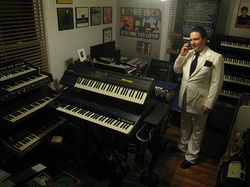 Gearporn- click for large image
Gearporn- click for large image 4- If money were no object, what one piece of gear would you buy?
A Moog modular. Its the classic musical modular. I am babysitting one now while a friend moves. Three cab monster with dual 960s and the rackmount Bode Frequency Shifter (serial no. 1 of 11, handwritten by Bob himself). A Buchla 100 would be mighty cool, too, though I am mostly into programming musical sounds as opposed to sound oriented music. I'm east coast, almost always.
A Moog modular. Its the classic musical modular. I am babysitting one now while a friend moves. Three cab monster with dual 960s and the rackmount Bode Frequency Shifter (serial no. 1 of 11, handwritten by Bob himself). A Buchla 100 would be mighty cool, too, though I am mostly into programming musical sounds as opposed to sound oriented music. I'm east coast, almost always.
5- What new modules do you have coming?
I'm too busy right now to release a new module. The last new module I released was the Fonzo Baker Tube Tribute (limited to 10) which was in honor of a customer's grandfather who had the most amazing life story. Truly a lost generation. Proceeds benefit the Wounded Warrior Foundation. I'm dabbling with a Synthi AKS VCF, but we'll see... Always building cool custom stuff for folks, I just never get to keep it. Lots of Buchla clones and euro conversions for 5U:
I'm too busy right now to release a new module. The last new module I released was the Fonzo Baker Tube Tribute (limited to 10) which was in honor of a customer's grandfather who had the most amazing life story. Truly a lost generation. Proceeds benefit the Wounded Warrior Foundation. I'm dabbling with a Synthi AKS VCF, but we'll see... Always building cool custom stuff for folks, I just never get to keep it. Lots of Buchla clones and euro conversions for 5U:

6- If you could be reincarnated as any animal, what would it be?
It's a dog's life...
Thanks Tony!
It's a dog's life...
Thanks Tony!

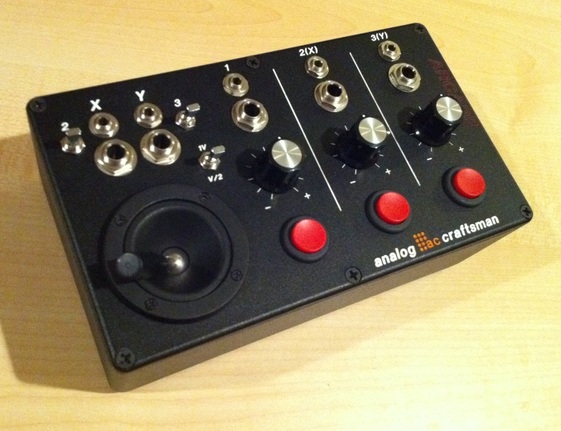
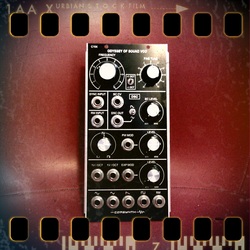
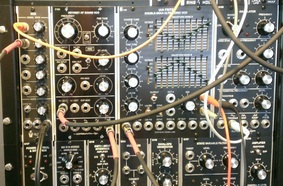
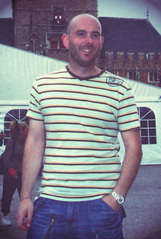
 RSS Feed
RSS Feed
